Selective release of ATP from sympathetic nerves of rat vas deferens by the toxin TsTX-I from Brazilian scorpion Tityus serrulatus
- PMID: 15678093
- PMCID: PMC1576030
- DOI: 10.1038/sj.bjp.0706062
Selective release of ATP from sympathetic nerves of rat vas deferens by the toxin TsTX-I from Brazilian scorpion Tityus serrulatus
Abstract
1. The effects of the main component of the Tityus serrulatus scorpion venom, toxin TsTX-I, were studied on the contractility and release of neurotransmitters in the rat vas deferens. Since TsTX-I is known to act on sodium channels, we used veratridine, another sodium channel agent, for comparison. 2. Toxin TsTX-I induced concentration-dependent contractions with an EC(50) value of 47.8+/-0.1 nM and a maximum effect of 84.4+/-10.4% of that for BaCl(2). 3. Contractions by TsTX-I were abolished by denervation or tetrodotoxin (0.1 microM), showing that the toxin effects depend on the integrity of sympathetic nerve terminals. 4. To check for the presence of a noradrenergic component, experiments were conducted after removal of adrenergic stores in nerve terminals by reserpinization (10 mg kg(-1), 24 h prior to experiments) or blockade of alpha(1) adrenoceptors by prazosin (30 microM), showing that these procedures did not modify the response to TsTX-I, and therefore that adrenoceptors were not involved in contractions. 5. To check for the presence of a purinergic component, experiments were carried out after blockade of P(2X) receptors by suramin (0.1 mM) or desensitization by alpha,beta-methylene-ATP (30 microM). These agents greatly abolished the contractile response to TsTX-I (about 83% by desensitization and 96% by suramin), showing the involvement of purinergic receptors. 6. The release of noradrenaline and purinergic agents (ATP, ADP, AMP and adenosine) was detected by HPLC. Together, the total release of purines in the presence of TsTX-I was about 42 times higher than in the control group. In contrast, TsTX-I did not modify the overflow of noradrenaline, showing that the release was selective for purines. 7. The release of purinergic agents was reduced by the N-type calcium channel blocker omega-conotoxin GVIA (1 microM) and by the P/Q-type blocker omega-conotoxin MVIIC (1 microM), showing that the effects of TsTX-I are calcium-dependent. 8. The results show that TsTX-I produced a selective release of purines from postganglionic sympathetic nerves in the rat vas deferens.
Figures
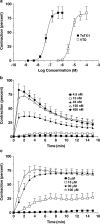
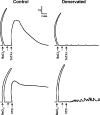
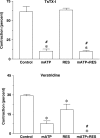
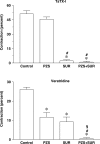
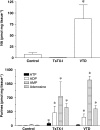
References
-
- ARISPE N., JAIMOVICH E., LIBERONA J.L., ROJAS E. Use of selective toxins to separate surface and tubular sodium currents in frog skeletal muscle fibers. Pflugers Arch. 1988;411:1–7. - PubMed
-
- BARHANIN J., GIGLIO J.R., LEOPOLD P., SCHMID A., SAMPAIO S.V., LAZDUNSKI M. Tityus serrulatus venom contains two classes of toxins. Tityus gamma toxin is a new tool with a very high affinity for studying the Na+ channel. J. Biol. Chem. 1982;257:12553–12558. - PubMed
-
- BARHANIN J., ILDEFONSE M., ROUGIER O., SAMPAIO S.V., GIGLIO J.R., LAZDUNSKI M. Tityus gamma toxin, a high affinity effector of the Na+ channel in muscle, with a selectivity for channels in the surface membrane. Pflugers Arch. 1984;400:22–27. - PubMed
-
- BARHANIN J., PAURON D., LOMBET A., NORMAN R.I., VIJVERBERG H.P., GIGLIO J.R., LAZDUNSKI M. Electrophysiological characterization, solubilization and purification of the Tityus gamma toxin receptor associated with the gating component of the Na+ channel from rat brain. EMBO J. 1983;2:915–920. - PMC - PubMed
Publication types
MeSH terms
Substances
LinkOut - more resources
Full Text Sources

